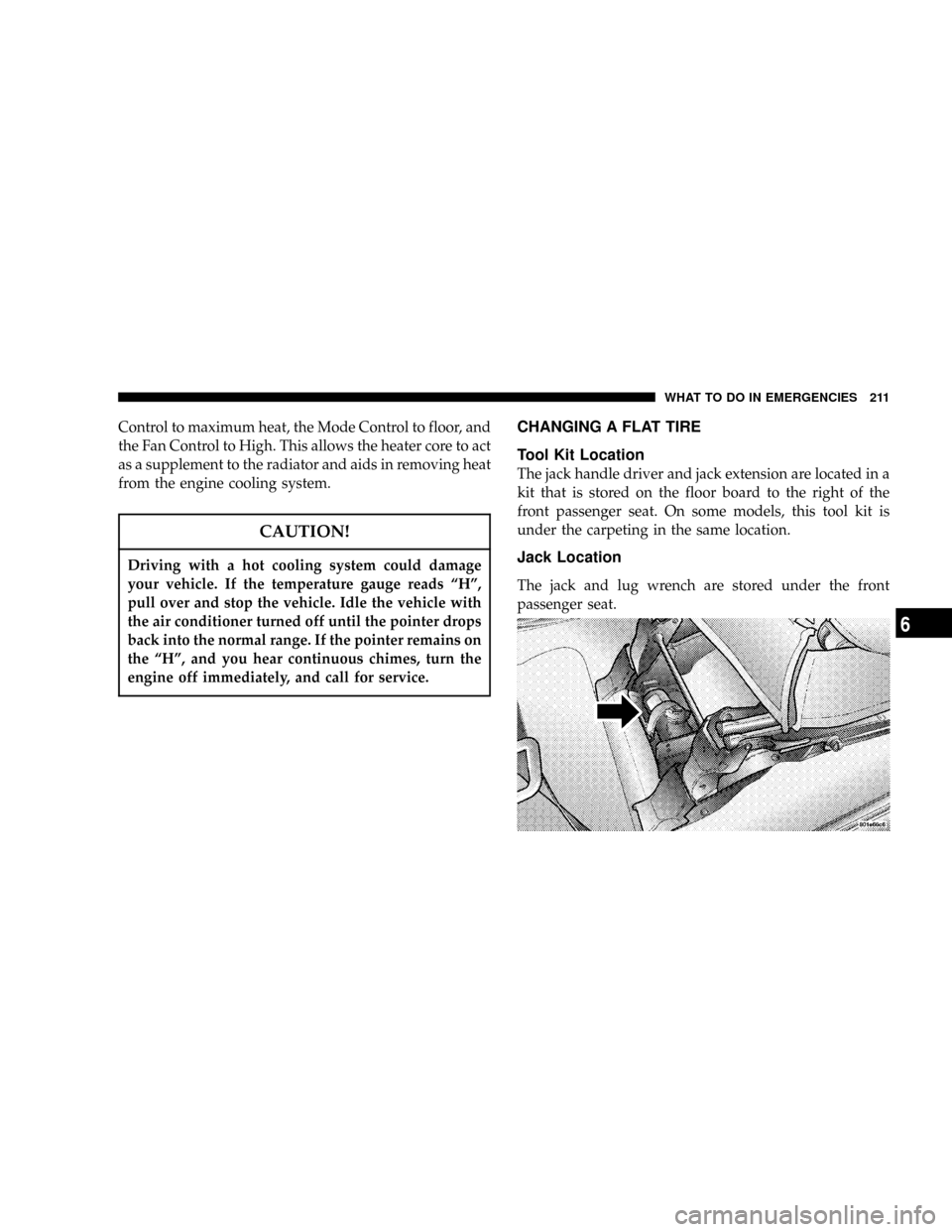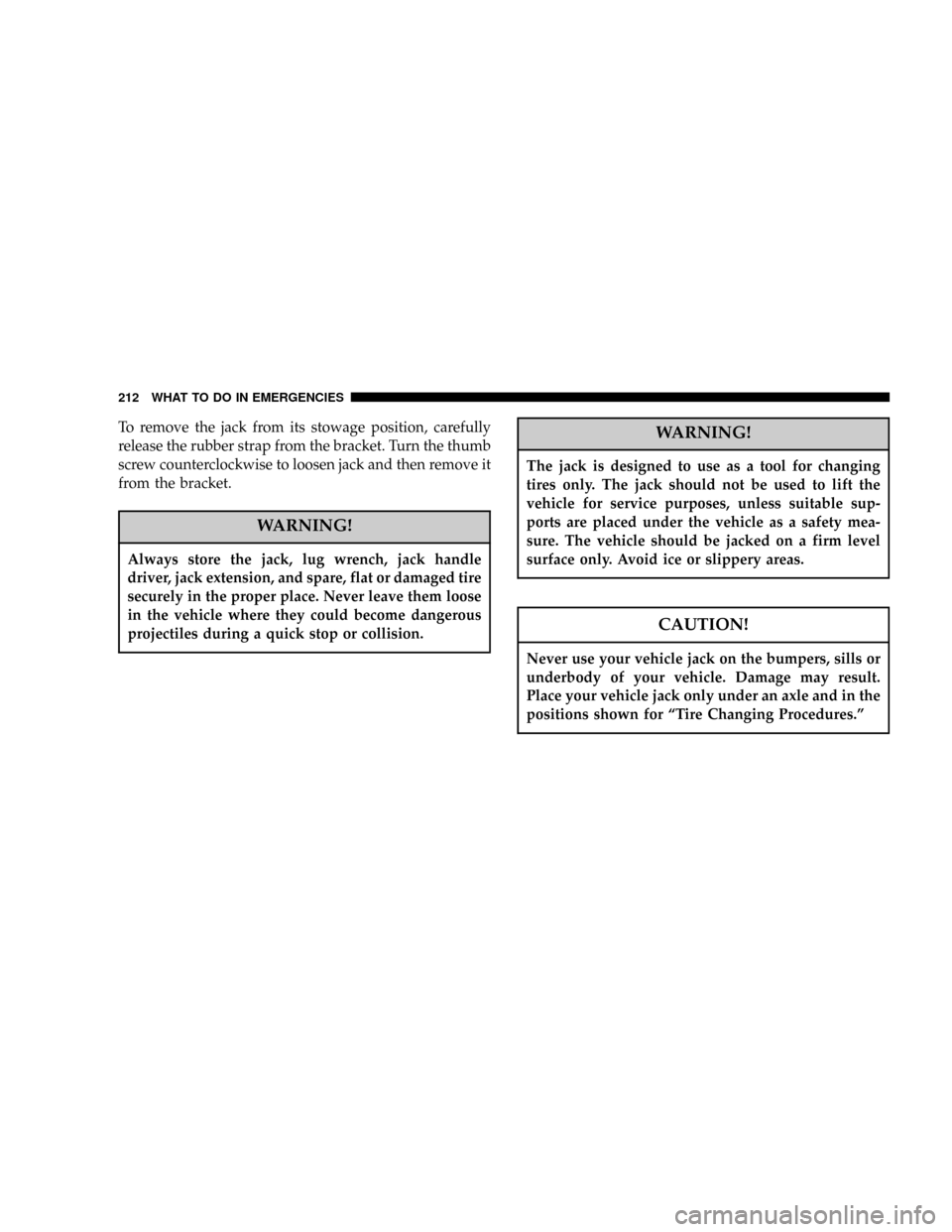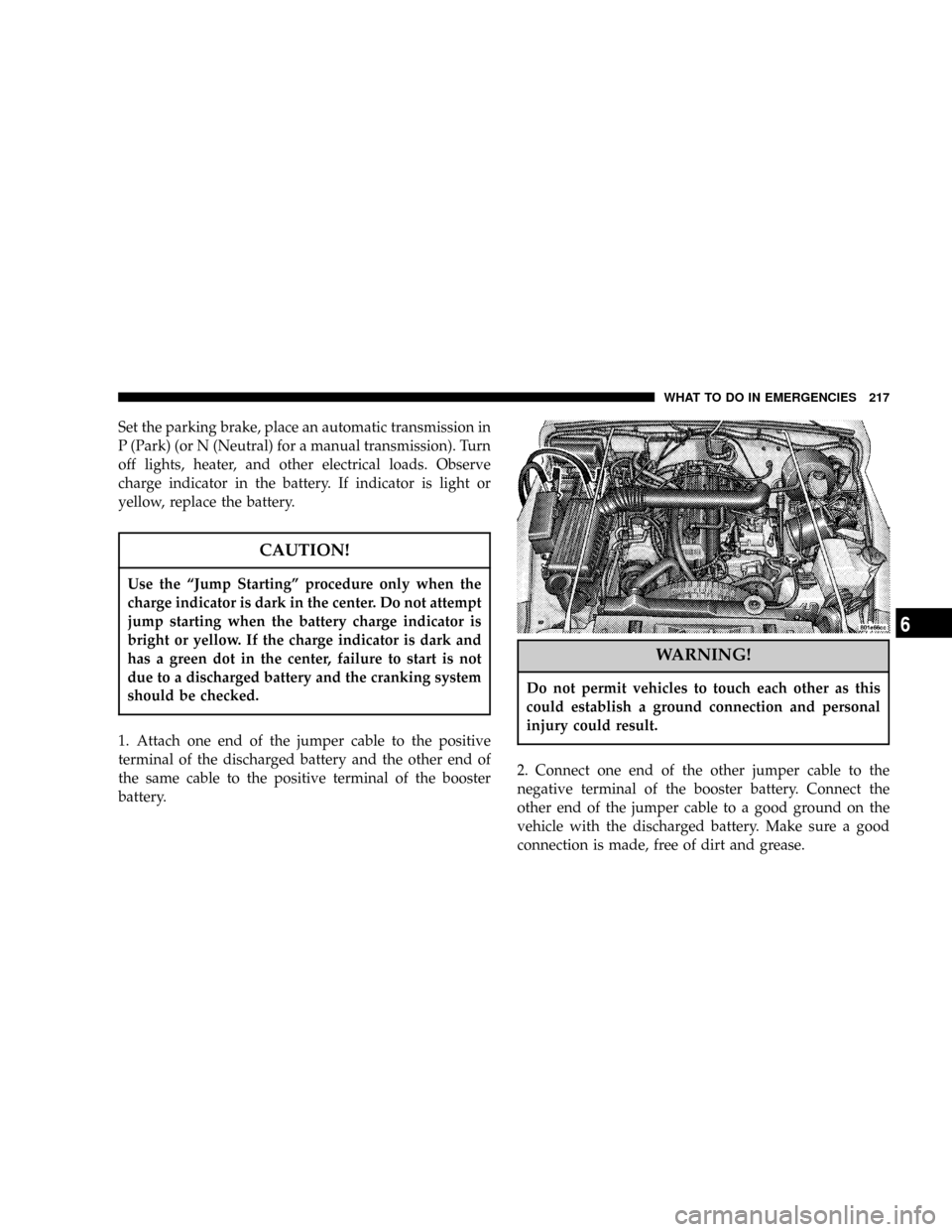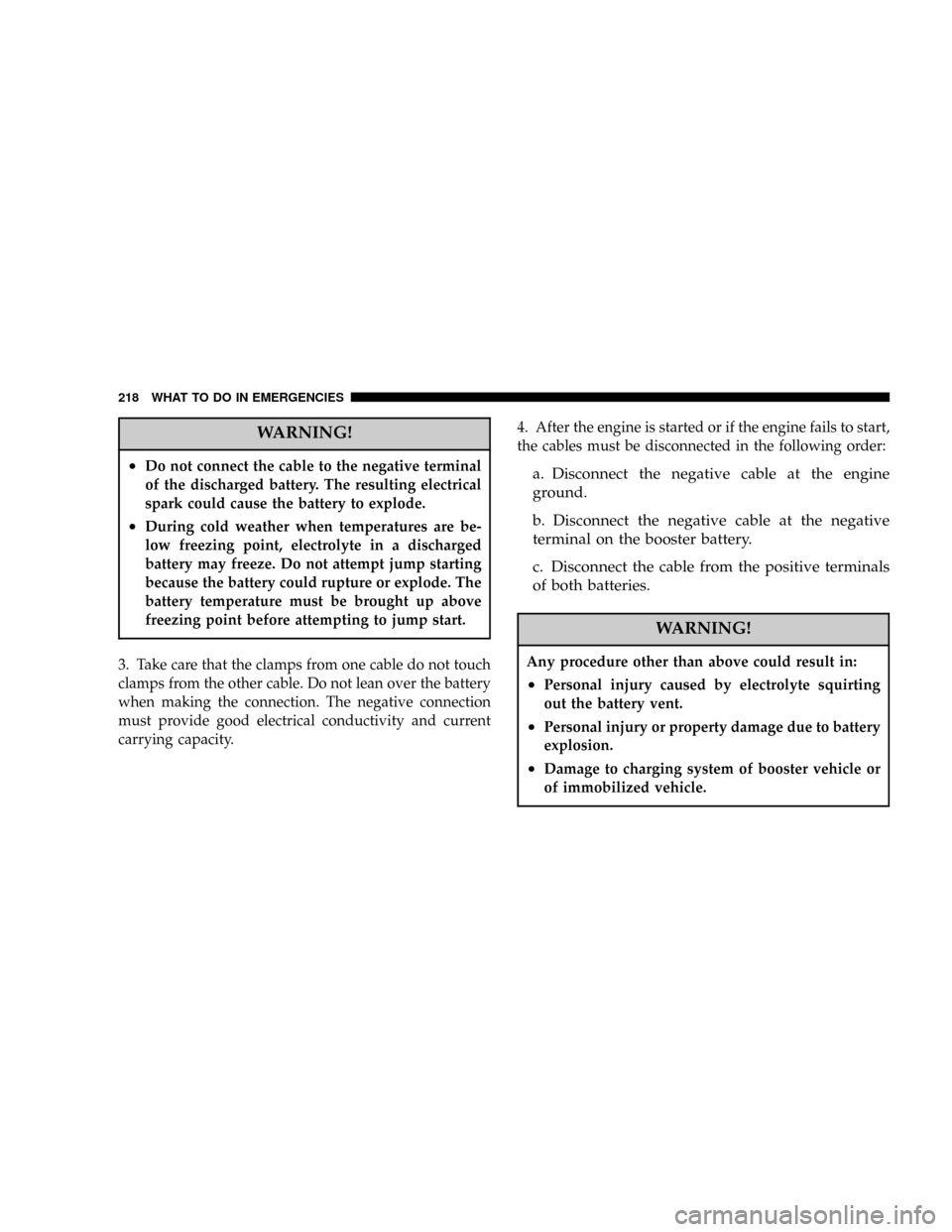JEEP WRANGLER 2004 TJ / 2.G Owners Manual
Manufacturer: JEEP, Model Year: 2004, Model line: WRANGLER, Model: JEEP WRANGLER 2004 TJ / 2.GPages: 299, PDF Size: 6.82 MB
Page 211 of 299

Control to maximum heat, the Mode Control to floor, and
the Fan Control to High. This allows the heater core to act
as a supplement to the radiator and aids in removing heat
from the engine cooling system.
CAUTION!
Driving with a hot cooling system could damage
your vehicle. If the temperature gauge reads ªHº,
pull over and stop the vehicle. Idle the vehicle with
the air conditioner turned off until the pointer drops
back into the normal range. If the pointer remains on
the ªHº, and you hear continuous chimes, turn the
engine off immediately, and call for service.
CHANGING A FLAT TIRE
Tool Kit Location
The jack handle driver and jack extension are located in a
kit that is stored on the floor board to the right of the
front passenger seat. On some models, this tool kit is
under the carpeting in the same location.
Jack Location
The jack and lug wrench are stored under the front
passenger seat.
WHAT TO DO IN EMERGENCIES 211
6
Page 212 of 299

To remove the jack from its stowage position, carefully
release the rubber strap from the bracket. Turn the thumb
screw counterclockwise to loosen jack and then remove it
from the bracket.
WARNING!
Always store the jack, lug wrench, jack handle
driver, jack extension, and spare, flat or damaged tire
securely in the proper place. Never leave them loose
in the vehicle where they could become dangerous
projectiles during a quick stop or collision.
WARNING!
The jack is designed to use as a tool for changing
tires only. The jack should not be used to lift the
vehicle for service purposes, unless suitable sup-
ports are placed under the vehicle as a safety mea-
sure. The vehicle should be jacked on a firm level
surface only. Avoid ice or slippery areas.
CAUTION!
Never use your vehicle jack on the bumpers, sills or
underbody of your vehicle. Damage may result.
Place your vehicle jack only under an axle and in the
positions shown for ªTire Changing Procedures.º
212 WHAT TO DO IN EMERGENCIES
Page 213 of 299

Spare Tire Location
To remove the spare tire from the carrier, remove the tire
cover, if equipped, and remove the lug nuts with the lug
wrench turning them counterclockwise. If equipped with
an anti-theft lug nut (A), use the ªKeyº (B) and the lug
wrench. The ªKeyº is stored in the glove box.
NOTE:If you have added aftermarket accessories to the
spare tire mounted carrier, it cannot exceed a gross
weight of 50 lbs (23 kg) including the weight of the spare
tire.
Tire Changing Procedures
WARNING!
You can be injured or killed if you try to change a
wheel too close to moving traffic. Pull far enough off
the road to avoid being hit when operating the jack
or changing the wheel.
Preparation
²
Park on a firm, level surface well off the road, to
provide ample work space. Place automatic transmis-
sion in P (Park), or manual transmission in R (Re-
verse), and stop engine. Set parking brake firmly and
activate hazard warning flasher.
WHAT TO DO IN EMERGENCIES 213
6
Page 214 of 299

²Get everyone out of the vehicle before you jack it up.
If the jack should fall, someone in the vehicle could be
hurt.
²Block tire diagonally oppo-
site tire to be changed to pre-
vent forward and backward
vehicle movement.
Instructions
1. Remove spare tire, jack and tools from stored location.
2. Before raising vehicle, loosen lug nuts on wheel with
flat tire.
3. Assemble the jack and jacking tools as shown. Connect
jack handle driver (1) to extension (2) then to lug wrench
(3).4. Operate jack from the front or the rear of the vehicle.
Place the jack under the axle tube, as shown.
214 WHAT TO DO IN EMERGENCIES
Page 215 of 299

5. Use a clockwise rotation to raise the jack. Raise vehicle
just enough to be able to remove flat tire and install spare
tire.
6. Remove lug nuts and wheel.
7. Position spare wheel/tire on vehicle and install lug
nuts with cone-shaped end toward wheel. Lightly tighten
nuts clockwise. To avoid the risk of forcing the vehicle off
the jack, do not tighten the nuts fully until the vehicle has
been lowered.
8. Lower the vehicle by using a counterclockwise rota-
tion to lower the jack.
9. Finish tightening the lug nuts securely in crisscross
pattern as shown. Tighten to 85-110 ft. lbs. (115-149 N´m).10. Remove jack assembly and wheel blocks.
11. Secure jack, lug wrench, jack handle driver, jack
extension, and tire in proper locations.
WARNING!
Carefully follow these tire changing warnings to
help prevent personal injury or damage to your
vehicle:
WHAT TO DO IN EMERGENCIES 215
6
Page 216 of 299

²Always park on a firm, level surface as far from the
edge of the roadway as possible before raising the
vehicle.
²Apply the parking brake firmly before jacking.
²Always block the wheel diagonally opposite the wheel
being raised.
²Do not raise the vehicle higher than is necessary to
remove the tire.
²Never start the engine with the vehicle on a jack.
²Do not let passengers sit in the vehicle when it is on a
jack.
²Do not get under the vehicle when it is on a jack.
²Failure to follow the ªTire Changing Procedureº may
result in personal injury or damage to your vehicle.
²Only use the jack in the positions indicated.
JUMP STARTING
WARNING!
To prevent personal injury or damage to clothing, do
not allow battery fluid to contact eyes, skin, or
fabrics. Do not lean over a battery when connecting
jumper cables or allow cable clamps to touch each
other. Keep open flames or sparks away from battery
vent holes. Always wear eye protection when work-
ing with batteries. Do not use a booster battery or
any other booster source that has a greater than
12±volt system, i.e. do not use a 24±volt power
source.
Your vehicle is equipped with a 12±volt battery. If it
becomes necessary to use a booster battery, with jumper
cables, to start the vehicle's engine because it's battery is
discharged, the following procedure should be followed:
216 WHAT TO DO IN EMERGENCIES
Page 217 of 299

Set the parking brake, place an automatic transmission in
P (Park) (or N (Neutral) for a manual transmission). Turn
off lights, heater, and other electrical loads. Observe
charge indicator in the battery. If indicator is light or
yellow, replace the battery.
CAUTION!
Use the ªJump Startingº procedure only when the
charge indicator is dark in the center. Do not attempt
jump starting when the battery charge indicator is
bright or yellow. If the charge indicator is dark and
has a green dot in the center, failure to start is not
due to a discharged battery and the cranking system
should be checked.
1. Attach one end of the jumper cable to the positive
terminal of the discharged battery and the other end of
the same cable to the positive terminal of the booster
battery.
WARNING!
Do not permit vehicles to touch each other as this
could establish a ground connection and personal
injury could result.
2. Connect one end of the other jumper cable to the
negative terminal of the booster battery. Connect the
other end of the jumper cable to a good ground on the
vehicle with the discharged battery. Make sure a good
connection is made, free of dirt and grease.
WHAT TO DO IN EMERGENCIES 217
6
Page 218 of 299

WARNING!
²Do not connect the cable to the negative terminal
of the discharged battery. The resulting electrical
spark could cause the battery to explode.
²During cold weather when temperatures are be-
low freezing point, electrolyte in a discharged
battery may freeze. Do not attempt jump starting
because the battery could rupture or explode. The
battery temperature must be brought up above
freezing point before attempting to jump start.
3. Take care that the clamps from one cable do not touch
clamps from the other cable. Do not lean over the battery
when making the connection. The negative connection
must provide good electrical conductivity and current
carrying capacity.4. After the engine is started or if the engine fails to start,
the cables must be disconnected in the following order:
a. Disconnect the negative cable at the engine
ground.
b. Disconnect the negative cable at the negative
terminal on the booster battery.
c. Disconnect the cable from the positive terminals
of both batteries.
WARNING!
Any procedure other than above could result in:
²Personal injury caused by electrolyte squirting
out the battery vent.
²Personal injury or property damage due to battery
explosion.
²Damage to charging system of booster vehicle or
of immobilized vehicle.
218 WHAT TO DO IN EMERGENCIES
Page 219 of 299

TOWING A DISABLED VEHICLE
The manufacturer recommends towing with all four
wheels off the ground. Acceptable methods are to tow the
vehicle on a flatbed or with one end of the vehicle raised
and the other end on a towing dolly.
WHAT TO DO IN EMERGENCIES 219
6
Page 220 of 299
